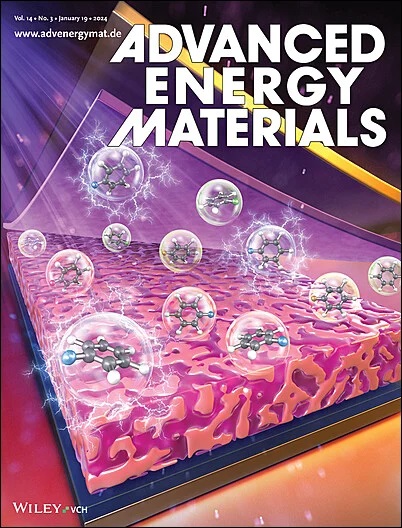在具有局部 W/Ni(Li)超结构的富镍锂氧化物中实现高电压稳定性
IF 24.4
1区 材料科学
Q1 CHEMISTRY, PHYSICAL
引用次数: 0
摘要
创造高能量密度阴极对于制造下一代锂离子电池至关重要。然而,沿着富锂或富镍氧化物这两个主要方向进行的材料探索遇到了瓶颈。为了摆脱这一僵局,本文通过设计一系列新的 Li1+yNi(3-5y)/3W2y/3O2 氧化物,巩固了 "富锂-富镍 "路线,这些氧化物具有高达 4.5 V 的高压循环稳定性和超过 230 mAh g-1 的高容量。研究发现,W6+在很大程度上融入了 LiNiO2 晶格,形成了 W/Ni(Li)反蜂巢有序纳米域。X 射线吸收光谱、共振非弹性 X 射线散射、透射电子显微镜和核磁共振都清楚地表明,这些富含锂的结构域能够实现可逆的阴离子氧化还原,这与电化学性能的改善息息相关。此外,鉴于在 W 取代的非富锂氧化物中也发现了类似的局部结构,因此无论锂的化学计量如何,W6+ 加入晶格都被证明是产生电化学活性富锂畴的关键。因此,这意味着高价阳离子在调整富镍氧化物结构和电化学方面的作用被低估了。这些结果凸显了富锂离子成分在实现可逆高容量方面的必要性,加强了开发先进阴极的 "富锂镍 "途径的前景。本文章由计算机程序翻译,如有差异,请以英文原文为准。

Achieving High-Voltage Stability in Li-Rich Ni-Rich Oxides with Local W/Ni(Li) Superstructure
Creating high-energy-density cathodes is crucial for building next-generation lithium-ion batteries. However, materials exploration along two main directions, namely Li-rich or Ni-rich oxides, has encountered bottlenecks. To get rid of the impasse, here a “Li-rich Ni-rich” route is consolidated by designing a new family of Li1+yNi(3-5y)/3W2y/3O2 oxides with high-voltage cycling stability up to 4.5 V and high capacities over 230 mAh g−1. It is discovered that W6+ is largely incorporated into the LiNiO2 lattice, forming W/Ni(Li) inverse honeycomb-ordered nano-domains. These Li-rich domains enable reversible anionic redox, clearly demonstrated by X-ray absorption spectroscopy, resonant inelastic X-ray scattering, transmission electron microscopy, and nuclear magnetic resonance, which is linked to improved electrochemical performance. Furthermore, the incorporation of W6+ into the lattice proves to be the key to generating electrochemically active Li-rich domains irrespective of Li stoichiometry given that a similar local structure is found in W-substituted non-Li-rich oxides. This therefore implies the underestimated role of high-valence cations in tuning the structure and electrochemistry of Ni-rich oxides. These results underline the necessity of a Li-rich composition in the request for reversible high capacity, reinforcing the promise of a “Li-rich Ni-rich” avenue for developing advanced cathodes.
求助全文
通过发布文献求助,成功后即可免费获取论文全文。
去求助
来源期刊

Advanced Energy Materials
CHEMISTRY, PHYSICAL-ENERGY & FUELS
CiteScore
41.90
自引率
4.00%
发文量
889
审稿时长
1.4 months
期刊介绍:
Established in 2011, Advanced Energy Materials is an international, interdisciplinary, English-language journal that focuses on materials used in energy harvesting, conversion, and storage. It is regarded as a top-quality journal alongside Advanced Materials, Advanced Functional Materials, and Small.
With a 2022 Impact Factor of 27.8, Advanced Energy Materials is considered a prime source for the best energy-related research. The journal covers a wide range of topics in energy-related research, including organic and inorganic photovoltaics, batteries and supercapacitors, fuel cells, hydrogen generation and storage, thermoelectrics, water splitting and photocatalysis, solar fuels and thermosolar power, magnetocalorics, and piezoelectronics.
The readership of Advanced Energy Materials includes materials scientists, chemists, physicists, and engineers in both academia and industry. The journal is indexed in various databases and collections, such as Advanced Technologies & Aerospace Database, FIZ Karlsruhe, INSPEC (IET), Science Citation Index Expanded, Technology Collection, and Web of Science, among others.
 求助内容:
求助内容: 应助结果提醒方式:
应助结果提醒方式:


